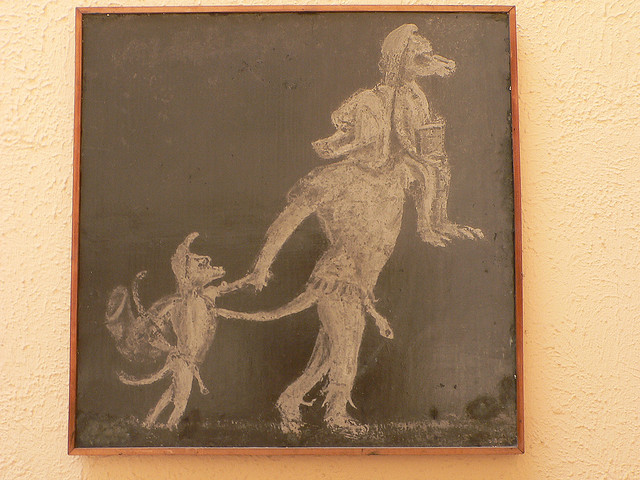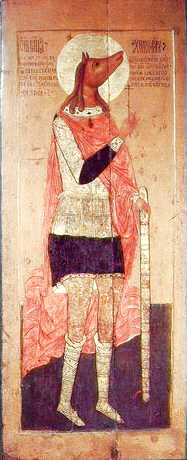The Dog-Headed Saint January 12, 2011
Author: Beach Combing | in : Ancient, Medieval , trackback
St Christopher is in many ways a typical early eastern saint.
He was for many years a prisoner of war: check.
He was a Roman soldier when he turned to Christ: check.
His staff miraculously took to life and began to bloom: check.
An angel – Raphael no less – gave him the gift of speaking Greek: check.
He was tortured for his faith and yet refused to be swayed: check.
He was martyred under the Emperor Decius: check.
He had a dog’s head…
Now don’t let that last point slip passed you as many of Beachcombing’s predecessors have done. Today the legend of St Christopher helping Christ cross the river has obscured the important canine detail: though the river fording is almost certainly a late addition. In the early Middle Ages the most famous thing about St Christopher was his dog’s head. Indeed, good St Chris is often portrayed thus in medieval manuscript and sculpture.
Beachcombing has looked before at the remarkable tradition of dogheads in antiquity, the idea that tribes of dogheaded men and women lived in distant lands. But why was Christopher particularly associated with these strange creatures?
One possible explanation is that Christopher was the Egyptian god Anubis in disguise. This explanationm suffers from a fatal flaw, however: the two have absolutely nothing in common bar their dog head and some associations – vague in the case of Christopher – with Egypt.
The answer is, instead, almost certainly to be found in an early misunderstanding of some of the grains of fact in the Christopher legend. Our most reliable early Life is full of suspect miraculous details, but it gives us one surprisingly circumstantial fact. It appears that Christopher served the Empire in the Cohors III Valeria Marmaritarum. If the name of this unit is to be taken at face value then these soldiers were Marmaritae a tribal people dwelling to the south-west of Egypt, outside the Imperial borders.
Of course, being outside the control of the Empire is hardly enough to justify being called a doghead. But what is interesting is that the first surviving description of this corner of the world, in Herodotus no less, tells us that it was here that the dogheads lived. Early on in the tradition of St Christopher an author perhaps innocently made the connection that was then afterwards taken seriously by hagiological duffers.
This interesting correspondence suggests that there may be some broader truths in Christopher’s early Life after all. He was perhaps captured by the Romans in one of their frontier wars: there is certainly the claim that he was at first a prisoner. He learnt Greek late in life whether or not an angel intervened: this would correspond perfectly with what we know of the non-Greek speaking Marmaritae. He was then presumably sucked into the special unit of Marmaritae created by the Empire to defend the borders: a typical late Imperial ploy. Other parts of the legend, meanwhile, do not stand up: for example Christopher was killed by Decius in his fourth year, while Decius only reigned for two years… But it looks as if by peeling off the dog mask we have, nevertheless, the outline of a remarkable biography: Barbarian warrior, Roman prisoner, Roman soldier, Christian martyr, doghead…
Beachcombing is always on the look out for doghead stories – but the who isn’t?: drbeachcombing AT yahoo DOT com
***
31 Jan 2011: Ostrich writes in with a provocative thought: ‘Purely idle speculation, and I wasn’t even going to mention it until you wrote ‘Or are we perhaps dealing with an outcast, common in legends across Euro-Asia, the young man who goes out into the wilderness and ‘wolfs’ around stealing and destroying.’ St. Christopher’s name before his conversion is traditionally given as Reprobus [Outcast]. Perhaps the pictures of Christopher with a dog’s head are really an artistic reference to ‘wearing the wolf’s head’? The name is usually written off as a hagiographical convention but this makes you think… Thanks Ostrich!
27 Feb 2011: Beachcombing is late to put this excellent post of JM up: ‘I… was especially excited by your recent post about St. Christopher. One of the most unusual parallels to that particular iconography was the depiction of Aeneas and his family as dogs in Roman wall painting. I can’t find an image of the original, but the link below is to a reproduction from the Museo della Civilità Romana in Rome (one of the most bizarre museums I’ve ever visited—a museum founded by Mussolini filled only with plaster casts and models of the great works of Roman art and archaeology, an Imperial greatest hits album). The thing that makes the comparison noteworthy is that both Aeneas and Christopher are known for heroically carrying children (Aeneas carrying Ascanius from burning Troy, and Christopher carrying a child who turned out to be Jesus across a river). ‘Christopher’ does come from the Greek for ‘Christ bearer’, after all. There’s no evidence saying that this is anything more than a coincidence, but I find it fascinating.’ Thanks JM! (And thanks too to Bill Jennings whose photo this is)
(And thanks too to Bill Jennings whose photo this is)
24/1/12: Howard writes in: ‘Anyway, I’ve just read this post and it seems to me you’ve overlooked one potential explanatory filter — Cynicism. It seems to me a short leap from “Christopher was a Cynic [κυνικός]” to “Christopher had a dog’s head.” Of course, no “just-so” story will ever provide a complete explanation of a legend, and it’s likely that any given symbol will evoke different responses for different audiences. But I find it hard to believe that at least some Hellenized Romans didn’t associate a dog-headed saint with the assimilation of Cynicism into the early church’. Thanks Howard!



